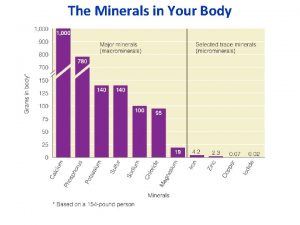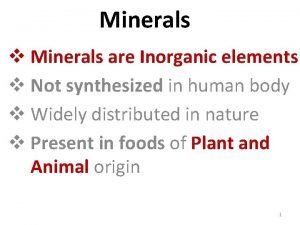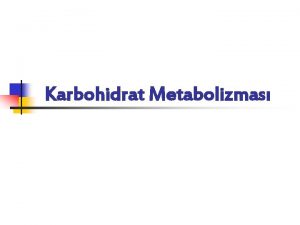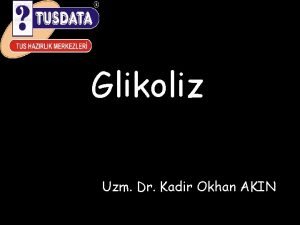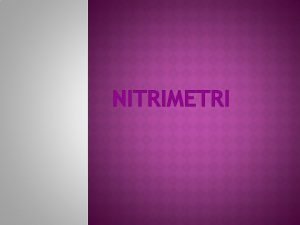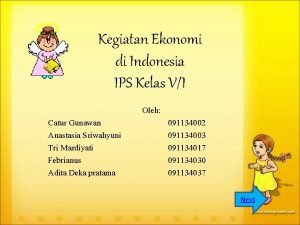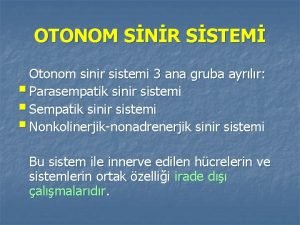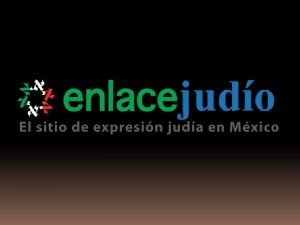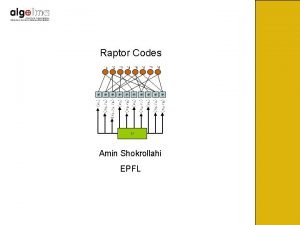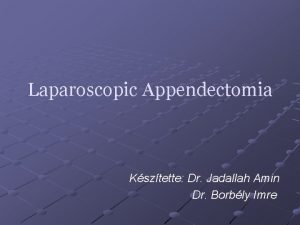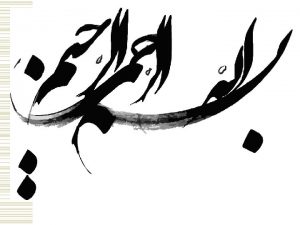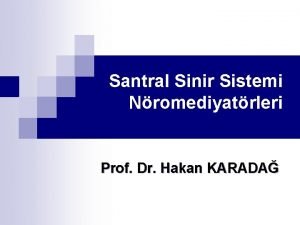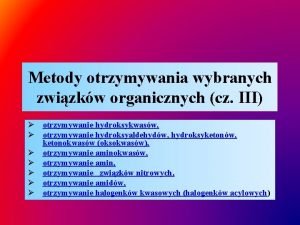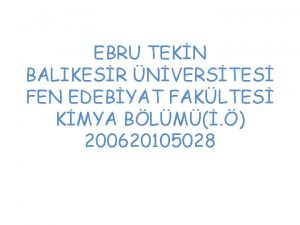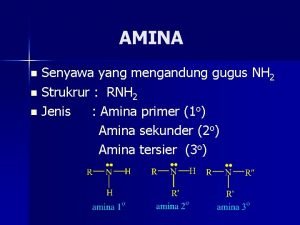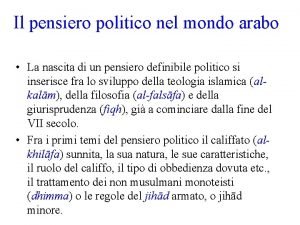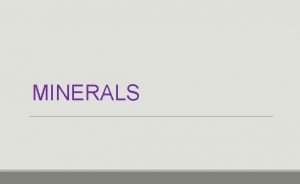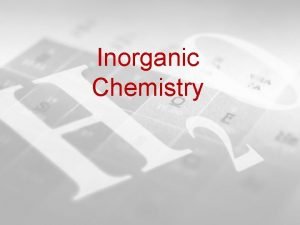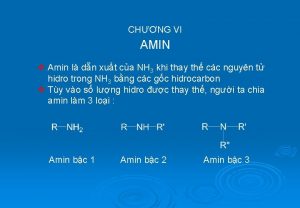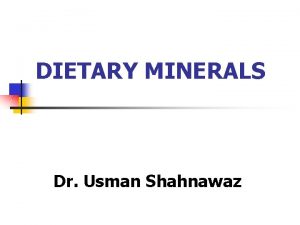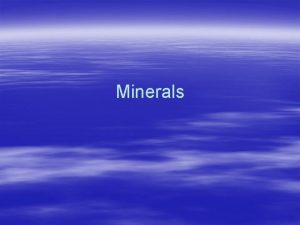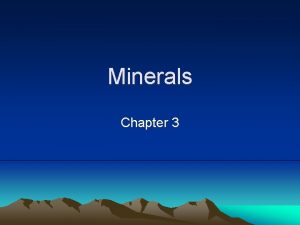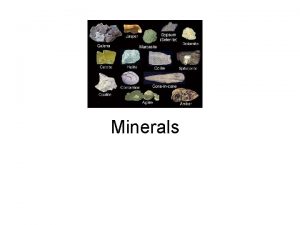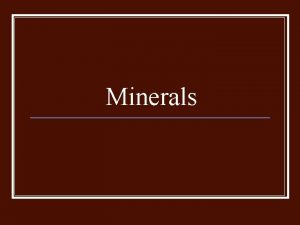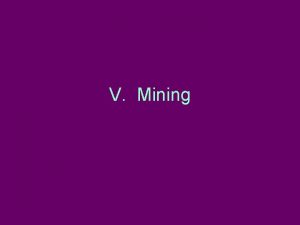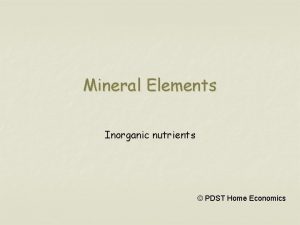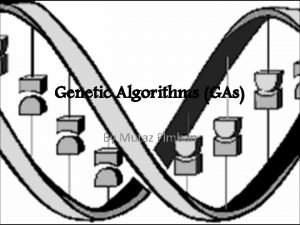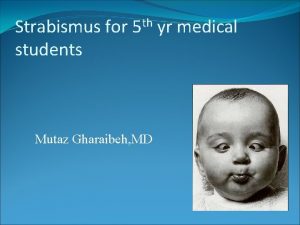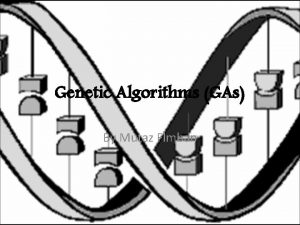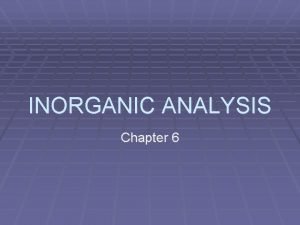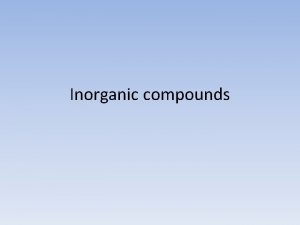MINERALS Mutaz Amin Minerals Minerals are inorganic elements































- Slides: 31

MINERALS Mutaz Amin

Minerals • Minerals are inorganic elements required in the diet. • Account for ~4% of body weight. • They are needed in small amounts (mg or μg).

Main role of minerals • They form the structure of bones and teeth • They control body fluids • They help enzymes to work (cofactors) • They help nerves to send signals. • They help muscles to function. •

Classification of minerals • Macrominerals • They are required in amounts greater than 100 mg/day. • Microminerals • They are required in amounts of 100 mg/day or less

Macro-minerals • Calcium • Phosphorus • Magnesium • Sodium • Potassium • Chlorine Micro-minerals • Chromium • Cobalt • Copper • Fluorine • Iodine • Iron • Manganese • Molybdenum • Selenium • Zinc

Calcium • RDA: Adult 1000 mg/day. • Sources: Dairy products, leafy green vegetables, legumes, tuna.

Functions of Calcium Nerve impulse Bone matrix Ca++ Blood clotting Muscle contraction

Calcium in the body • 99% in bones and teeth in the form of hydroxyapatite. • 1% in blood ionized form (Ca 2+)

Calcium deficiency • Rickets in children • Osteomalacia in adults • Osteoporosis in adults

Phosphorus • RDA: Adult 800 mg/day • Sources: dairy products, meat, fish, eggs, whole grains are good sources

Functions of Phosphorus • Formation of bone and teeth • Structure of cell membranes • Energy metabolism (ATP) • Nucleic acid formation

Deficiency of phosphorus • It is found in many foods and is unlikely to be in short supply in diets. • Deficiency signs: similar to calcium deficiency, weakness, impaired growth.

Sodium • RDA: Adult 500 mg/day • Sources: Table salt, Preserved foods, Cheese

Functions of Na • Extracellular cation • Regulates body water content • Nerve function. • Absorption of glucose from the intestine.

Diseases of Na • Deficiency: Hypotension • Excess intake: Hypertension

Potassium • RDA: Adult 1600 mg/day • Sources: Fruits, Vegetables, Milk, Coffee

Functions of Potassium • Regulate water balance in the body • Muscle function • Nerve function

Hypokalemia • Dehydration • Muscular weakness -paralysis • Mental confusion • Cardiac arrest • Death

Hyperkalemia • Cardiac arrest ("heart attack"). • Weakness and paralysis.

Chloride • RDA: 1400 mg per day • Sources: Table salt ( Na. Cl), olives

Functions of Cl • Fluid balance • Digestion of food ( HCl formation)

Diseases of Cl • Deficiency: muscle cramps • Excess: fluid retention

Microminerals

Iron • RDA: Females = 15 mg per day, Males = 10 mg per day • Sources: Liver, eggs, meats, fruits, vegetables

Absorption of Iron • Iron from animal sources is easier for the body to absorb. • Absorption is increased by ascorbic acid • Absorption is decreased by Ca 2+, phytates and tannins.

Functions of Iron • Formation of hemoglobin and myoglobin • Energy release

Deficiency of Iron

Excess of Iron Hemochromatosis • Mostly in males who take iron supplements or post menopausal females. • Stores of iron can increase over time and accumulate in liver causing liver toxic levels.

Zinc • RDA: 15 mg per day • Sources: Meats Fish Vegetables, products dairy Grains

Functions of Zinc • cofactor for many enzymes • Growth and repair. • Normal reproductive development. • Skin formation and wound healing

Deficiency of Zinc • Growth failure in children • Sexual retardation • Infections • Poor wound healing • Loss of taste and smell
 Antigentest åre
Antigentest åre Enzim
Enzim Minerals are inorganic elements that the body
Minerals are inorganic elements that the body Endoglikozidaz nedir
Endoglikozidaz nedir Fruktoz 2 6 bifosfat
Fruktoz 2 6 bifosfat Quality management assignment
Quality management assignment Prinsip kerja titrasi nitrimetri
Prinsip kerja titrasi nitrimetri Iktua
Iktua Jasmine amin chelsea
Jasmine amin chelsea Michelle amin
Michelle amin Bronkodilatasyon sempatik
Bronkodilatasyon sempatik Husseini
Husseini Raptor
Raptor Quang trung
Quang trung Ghazala amin
Ghazala amin Ghazala amin
Ghazala amin Maijdee balika bidyaniketan
Maijdee balika bidyaniketan Peyman milanfar
Peyman milanfar Pendapat ulama tentang kehujjahan mazhab shahabi
Pendapat ulama tentang kehujjahan mazhab shahabi Dr. jadallah
Dr. jadallah Amin rashidi
Amin rashidi Glutamat nedir
Glutamat nedir Fenylohydroksyloamina
Fenylohydroksyloamina Goplar bazar high school
Goplar bazar high school Amin hossein rahimi
Amin hossein rahimi Ftalimit
Ftalimit Nader amin-salehi
Nader amin-salehi Amin alipour
Amin alipour Pentamida
Pentamida Qasim amin
Qasim amin E.a technique (m) berhad
E.a technique (m) berhad Php my amin
Php my amin

